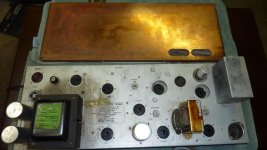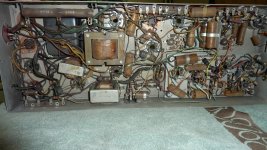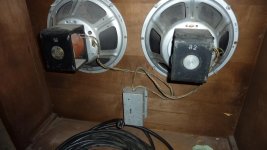Hi, I am new to forums in general. I have come across a Wurlitzer Model 6150 Tube Amp and a double 12" cabinet. It does not have the tubes though it looks in great condition, no signs of burns or blown fuse. How easy would it be to convert this to a guitar head amp. Any resources to help the convert would be great. I am not a technician, but I can read schematics, follow directions, solder and under stand the basic concepts of amplifiers. I am not able to test it since the tubes are gone, but I could ohm out everything at least.
Here is a list of the features and tube sockets:
Tubes: 2 = 6L6, 1 = 5U4G, 2 = 6SK7, 3 = 6SN7GT, 2 = 6F5 RCA RADIOTRON
ELECTRON TUBE.
Transformer: p-2955 = 115v 60cy, red/yellow 400-400vc AC
PORTS: ECHO, SWELL, INPUT, ACCESSORY, CONTROL, OUTPUT TO CABINET
Controls: Volume, Pedal 1-2-3, Tremulant 1-2-3.
Amp says 120 volts 60 cycle 180watts.
I am open to any suggestions to what I should do with this setup and information on how to do it and where to get parts.
I think a guitar head amp is the best choice. I would also be willing to convert to a stereo amp for music. And at very least trash it all except the case and the tube sockets, maybe the transformer and make a amp from scratch from a Dynaco schematic.
Thanks for looking
Here is a list of the features and tube sockets:
Tubes: 2 = 6L6, 1 = 5U4G, 2 = 6SK7, 3 = 6SN7GT, 2 = 6F5 RCA RADIOTRON
ELECTRON TUBE.
Transformer: p-2955 = 115v 60cy, red/yellow 400-400vc AC
PORTS: ECHO, SWELL, INPUT, ACCESSORY, CONTROL, OUTPUT TO CABINET
Controls: Volume, Pedal 1-2-3, Tremulant 1-2-3.
Amp says 120 volts 60 cycle 180watts.
I am open to any suggestions to what I should do with this setup and information on how to do it and where to get parts.
I think a guitar head amp is the best choice. I would also be willing to convert to a stereo amp for music. And at very least trash it all except the case and the tube sockets, maybe the transformer and make a amp from scratch from a Dynaco schematic.
Thanks for looking
Attachments
What do you mean rebuild. Do you mean add in new input and output jacks, add gain, bass and treble and get rid of the pedal switch, tremulant switch and echo, swell, control, accessory ports? Basically simplify the design? Does anyone have a similar schematic or resources talking about adding the gain, bass, treble and changing the input and outputs to 1/4" jacks?
Thanks for your response
Thanks for your response
By rebuild I mean replace all the old electrolytic capacitors and all other leaky capacitors plus any faulty components you find.
Yes, you will need to add gain, bass and treble if it doesn't already have them. Beware that passive tone controls will attenuate the signal so you may need to add a stage of amplification if you add tone controls.
Yes, you will need to add gain, bass and treble if it doesn't already have them. Beware that passive tone controls will attenuate the signal so you may need to add a stage of amplification if you add tone controls.
ssombret007. The Wurlitzer 6140 is the amplifier from an early Wurlitzer Model 50 organ. I too am looking for schematics for this to find out exactly what is possible with this amp. I was lucky enough to save the organ, which was out in the weather for several months, from being thrown away. The only thing that was worth salvaging was the 6140 amp. All the rest had rotted away. What a shame! The owner also gave me a chopped up Wurlitzer tone cabinet, model 75, that was still stored inside and contained 2 15", 2 12" plus 2 6420 amplifiers. The 6420 amps make for some very nice HiFi audio amps. Theres a post of the 6420 on this site. I will let you know if I find the schematic. I would appreciate if you do the same 
You are very lucky as those are field coil speakers. At least a third of the amp will be a power supply for the field coils. I would say that it would be a real waste to use those speakers in a guitar amp, for one thing they are probably worth a lot of money and would probably make excellent midrange hifi speakers.
Shoog
Shoog
Wurlitzer used Magnavox speakers and some of their early versions were actually designed by Peter Jensen. Known now to all by Jensen. I am familiar with the speaker marked with the "68" but not the one marked "82". The 68 speaker is a full range field coil and make decent Guitar speakers. The same 68 speaker is used in many early Wurlitzer organs.
I would actually guess they used two differently voiced speakers back in the day as is very common practice in todays " boutique " amps.
I'm curious to know what letters/numbers are on both of them. That would answer the question if they are tonally different.
Would love to see the front cone of the 82!
I would actually guess they used two differently voiced speakers back in the day as is very common practice in todays " boutique " amps.
I'm curious to know what letters/numbers are on both of them. That would answer the question if they are tonally different.
Would love to see the front cone of the 82!
might want to get the tubes first, then see, if, and i mean if, you need to rebuild anything.
almost all the old tube amps i have, function ok without replacing anything.
start them slowly with a variable transformer.
in the 20 or so years i've been buying from these people,
they have only ripped
me off for $4 .
so i'm not too unhappy.
https://www.fairradio.com/catalog.php?mode=view&categoryid=1417
almost all the old tube amps i have, function ok without replacing anything.
start them slowly with a variable transformer.
in the 20 or so years i've been buying from these people,
they have only ripped
me off for $4 .
so i'm not too unhappy.
https://www.fairradio.com/catalog.php?mode=view&categoryid=1417
Last edited:
sombre, this would be a great amp to learn restoration, but I think it would require you to do a fair bit of self-learning on many aspects of amp design and practical restoration - which may be exactly what you want to achieve 
I suggest you firstly need to adapt a similar, or trace out, the circuit schematic. This would be the start of the learning curve. Google searching, or posting on an organ forum can help, but I know some organ communities seem only to entertain you buying the workshop manual.
Just trying to quickly fire up the amp is to my mind not a good idea for this vintage of amp. Restorations take time, and often need you to interpret what was the original design intent -and hence what needs to change to make it suitable for another application. Quirky things also pop up, like why did someone add in a diode bridge across the valve base, but not connect the + terminal.
Ciao, Tim
I suggest you firstly need to adapt a similar, or trace out, the circuit schematic. This would be the start of the learning curve. Google searching, or posting on an organ forum can help, but I know some organ communities seem only to entertain you buying the workshop manual.
Just trying to quickly fire up the amp is to my mind not a good idea for this vintage of amp. Restorations take time, and often need you to interpret what was the original design intent -and hence what needs to change to make it suitable for another application. Quirky things also pop up, like why did someone add in a diode bridge across the valve base, but not connect the + terminal.
Ciao, Tim
cool, look at all those chiclet stuff. what I would do is sell the speakers, get guitar speakers, strip all the stuff out and go from there. Have you looked under the tube shield?(square silver box)
then you'll have something to start with. maybe starting with something like a J-12a for a classic sound.
It is discouraged to use field coil speakers on units that have exposed chassis grounds. This goes double for guitar amps since the ground is part of the guitar circuit. Once your amp is built, take it to a TV repair shop to test for leakage currents. The reason behind this is the fact you are recycling parts and absolute safety measures must be performed to prevent the risk of electrical shock. After all, you will be touching the ground electrically when you play.
then you'll have something to start with. maybe starting with something like a J-12a for a classic sound.
It is discouraged to use field coil speakers on units that have exposed chassis grounds. This goes double for guitar amps since the ground is part of the guitar circuit. Once your amp is built, take it to a TV repair shop to test for leakage currents. The reason behind this is the fact you are recycling parts and absolute safety measures must be performed to prevent the risk of electrical shock. After all, you will be touching the ground electrically when you play.
Attachments
Last edited:
- Status
- This old topic is closed. If you want to reopen this topic, contact a moderator using the "Report Post" button.
- Home
- Live Sound
- Instruments and Amps
- Wurlitzer 6150 Organ Tube Amp convert Guitar Amp


